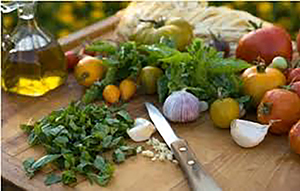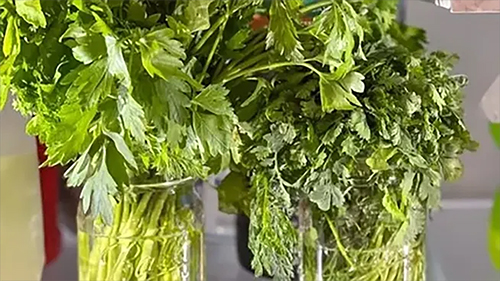Let It Grow
By Tammy Thornton
When I first started cooking on my own, one page in particular of a now-forgotten cookbook laid the groundwork for years of delicious foods to come. A little chart demystified spices and herbs by showing which ones were most compatible with certain foods. Nowadays, I’m more inclined to make my own rules and experiment with different flavors, but knowing the basics certainly helps the process. Fresh herbs can elevate any dish both in taste and presentation. Growing your own herbs will ensure you always have the freshest picks only steps away from your kitchen.
Let’s start with some easy-to-grow herbs. Lemon thyme is one of my favorite versatile herbs to grow and use in cooking. When you rub the tiny little leaves in your hands, they give a lemony aroma. They are a perfect addition to most savory dishes including fish, chicken, pork chops, vegetables, and potatoes. These cold-hardy plants are happy in full sun and will produce dainty little flowers that are also edible.
Parsley is another cold-hardy herb that can be grown year-round in our gardens by the shore. You can add parsley to anything from chicken to pasta as well as potatoes and vegetables. My favorite way to use parsley is by whizzing up a chimichurri sauce to pour over steak.

Speaking of steak, finely chop rosemary to use when marinating steak and save some for an accompaniment of red bliss potatoes. Feeling hungry yet? Rosemary also tastes delicious with chicken thighs, lemon, and olive oil. This herb is slightly harder to grow than parsley or thyme, but once established, rosemary can grow for years to come. If you are lucky, your rosemary will form deliciously aromatic blue or white flowers. As with most herbs, use kitchen scissors to finely cut the pine needle-like leaves.
Feeling a little spicy? Grow cilantro so that you make salsa and pico de gallo whenever the spirit moves you. There are two types of people in this world: those who must have cilantro on their tacos and those who think that cilantro tastes like soap. If you fall into the former group, get ready to plant cilantro seeds now. Cilantro is a cool-season plant so you’ll want to get started early in spring. Once the weather becomes too hot, cilantro will shift into survival mode and begin to bolt. The flavor will not be as good, and the plant will begin to produce flowers and then seed. Even then, all is not lost. You can save cilantro seeds (coriander) for growing the next generation of cilantro plants or save the coriander for other types of dishes. Add whole coriander seeds to curry, stew, or pickled vegetables. To release the flavor of coriander seeds, dry-fry them in a pan. You can also crush coriander seeds and use them on eggs, ham, chicken, pork, and potatoes.

Store herbs in a glass of water in the refrigerator.
Though the list goes on and on (we haven’t even mentioned the joys of sage, dill, or chives!), we certainly can’t skip my favorite herb, basil. You simply can’t substitute the flavor of fresh basil when it comes to bruschetta, pesto, or layered with mozzarella and home-grown tomatoes. Like the tomatoes, we must be patient a little longer with basil, since it absolutely cannot handle cold temperatures. If you can’t wait until May for your basil fix, try growing it indoors in a sunny draft-free window.
If you don’t normally cook with fresh herbs, give it a try. Simply adding fresh chives or parsley to your favorite dish will add an extra richness of flavor and will make your entree more visually appealing. Experiment with different combinations, then let us know about your favorite herb to grow and use in recipes. We would love to hear from our readers. Send your comments and questions to shorelocalgardener@gmail.com.
Tammy Thornton lives with her husband, children, and crazy pets while enjoying a life of gardening, cooking, and going to the beach.










